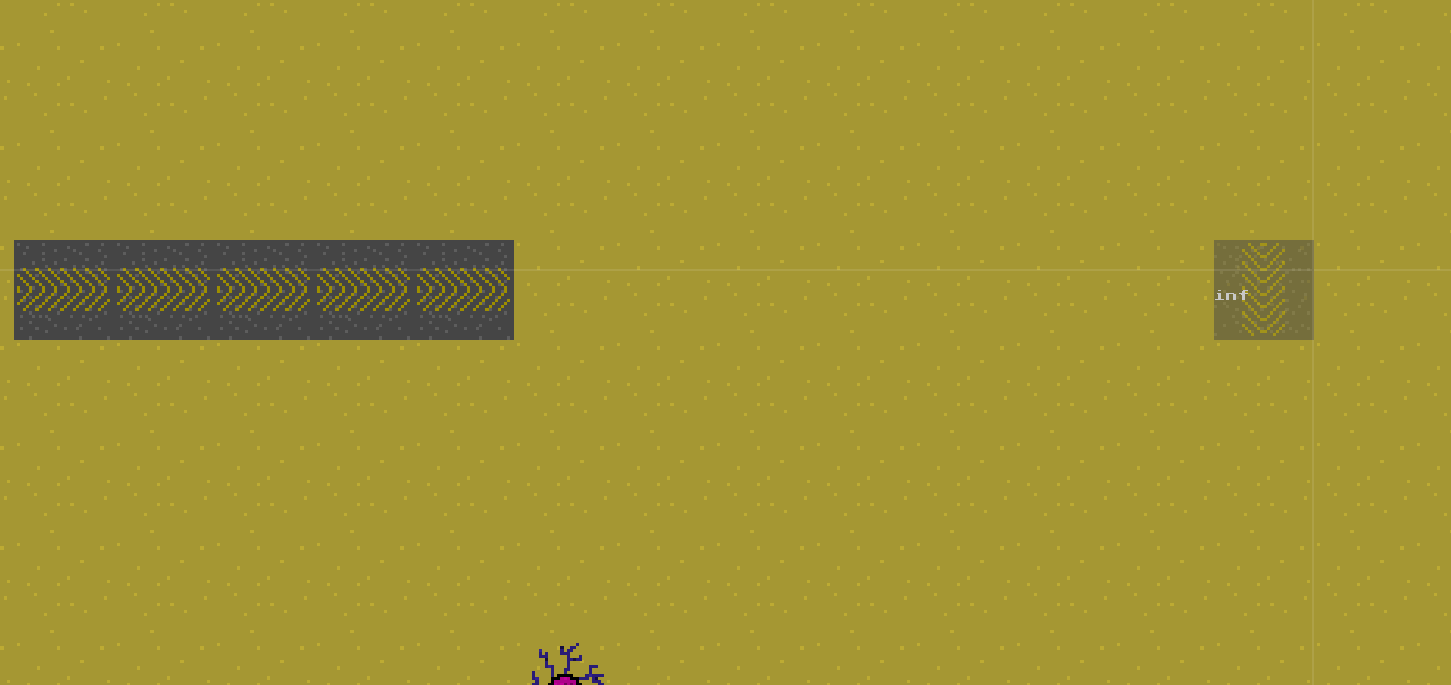Cursor cross
I added a cursor cross to make it easier to align Structures. This is especially handy when placing Belts.

Structure container improvements
Over the past weeks I applied several improvements to how Structures are tracked.
Deduplicate code
Initially both the Blueprint and Planet kept track of their Structures individually.
While there was a shared container type both were using, the Planet tracked more data as part of various optimizations.
I moved all that into StructContainer so Blueprint could also benefit from existing and future optimizations.
Quad tree for find and visibility
I previously optimized the rendering to only consider visibile Structures. This was a great improvement, but still had to iterate all Structures:
for (id, element) in self.planet.elements().iter().enumerate() {
if Self::is_visible(self.module_store, ¤t_area, &element) {
//render here
With a QuadTree as member of the StructContainer it’s now possible to query it for Structures in an area:
impl StructContainer {
...
pub fn for_all_in<F>(&self, area: &Area, f: &mut F)
where
F: FnMut(&PosElement),
{
...
self.pos_tree.borrow().for_all_in(area, f);
}
...
}Which can then be used during rendering:
self.planet
.structs()
.for_all_in(¤t_area, &mut |x: &PosElement| {
//render here
It’s now also used to find Structures by position:
impl StructContainer {
...
pub fn get_id(&self, ms: &dyn MS, pos: &Pos<i64>) -> Option<StructureID> {
...
self.pos_tree
.borrow()
.find(pos.x as f64, pos.y as f64)
.map(|e| e.id)
}
...
}Position storage
Before using the QuadTree as described above, the positions were stored in a map:
pub struct StructContainer {
positions: BTreeMap<Pos<i64>, StructureID>,
...
}
Since all lookups now happen via the tree, there’s no need to store the positions separately anymore, since Structures are already stored with their positions attached:
pub struct ContainerElement {
pub pos: PosAnchor<i64>,
pub rot: Rot,
pub sm: StructureModule,
}
...
pub struct StructContainer {
elements: Vec<ContainerElement>,
...
}Dedicated visibility tree
The above approach still had one major flaw:
Structures that are not inside the current view aren’t rendered. This sounds like the expected result, but some Structures have a greater visual impact than their size. For example the Influence has only a size of 1x1, but has a large visual indicator for the Influence area.
To keep track of that I extended Structures with:
fn visibility_range(&self, ms: &dyn MS) -> u32;
And am using an AABB-Tree (axis aligned bounding box) to keep track of of the visibilities:
pub struct VisibilityElement {
pub pos: Pos<i64>,
pub range: u32,
pub id: StructureID,
}
...
pub struct StructContainer {
...
vis_tree: RefCell<AABBTree2D<VisibilityElement>>,
...
}
which is now used for the visibility check during rendering instead of the QuadTree.
Dirty flags
I also introduced dirty flags for all the search structures to avoid unnecessary recalculation of those.
pub struct StructContainer {
...
vis_tree_dirty: RefCell<bool>,
...
}
...
impl StructContainer {
...
pub fn add(&mut self, ms: &dyn MS, element: ContainerElement) -> AddResult {
...
*self.vis_tree_dirty.borrow_mut() = true;
Ok(())
}
...
pub fn for_all_visible_in<F>(&self, ms: &dyn MS, area: &Area, f: &mut F)
where
F: FnMut(&VisibilityElement),
{
self.update_search_trees(ms);
...
self.vis_tree.borrow().for_each_collision_candidate(&bb, f)
}
...
fn update_search_trees(&self, ms: &dyn MS) {
...
if *self.vis_tree_dirty.borrow() {
...
*self.vis_tree_dirty.borrow_mut() = false;
}
}
}